Construction of Urban Environmental Performance Evaluation System Based on Multivariate System Theory and Comparative Analysis: A Case Study of Chengdu-Chongqing Twin Cities, China
Abstract
1. Introduction
2. Materials
2.1. Study Area
2.2. Data Resources
2.3. Construction of Environmental Performance Evaluation Indicator System
3. Methodology
3.1. AHP Method
- (1)
- Constructing the judgment matrix
- (2)
- Calculation of subjective weight
- (3)
- Consistency testing
3.2. Entropy Method
- (1)
- Considering that there are some differences between the attributes of different environmental performance evaluation indicators, the environmental performance evaluation indicators with negative attributes are first positivized according to Equation (8). Among them, refers to the negative indicator, refers to the positive indicator and the negative indicator which has been positivized.
- (2)
- In order to standardize the scale of the processed environmental performance evaluation indicators, the data were standardized in this study, as shown in Equation (9).
- (3)
- Based on the indicator data calculated in Equation (9), the comparative information entropy of each environmental performance evaluation indicator is calculated in Equation (10), as well as combined with Equation (11) to calculate its corresponding pair of information utility values .
- (4)
- Finally, the utility value obtained from Equation (12) is used as the basis for assigning weights to each indicator so that the th environmental performance evaluation indicator is assigned an objective weight value corresponding to it.
3.3. Portfolio Empowerment
3.4. Norms and Rules for Judging Indicators
4. Results and Discussion
5. Conclusions
Author Contributions
Funding
Institutional Review Board Statement
Informed Consent Statement
Data Availability Statement
Conflicts of Interest
References
- Li, W.; Mauerhofer, V. Behavioral patterns of environmental performance evaluation programs. J. Environ. Manag. 2016, 182, 429–435. [Google Scholar] [CrossRef] [PubMed]
- Griggs, D.T.; Smith, M.S.; Rockström, J.; Öhman, M.C.; Gaffney, O.; Glaser, G.; Kanie, N.; Noble, I.; Steffen, W.; Shyamsundar, P. An integrated framework for sustainable development goals. Ecol. Soc. 2014, 19, 49. [Google Scholar] [CrossRef]
- Hák, T.; Janoušková, S.; Moldan, B. Sustainable Development Goals: A need for relevant indicators. Ecol. Indic. 2016, 60, 565–573. [Google Scholar] [CrossRef]
- Wang, C.C.; Geng, L.N.; Rodriguez-Casallas, J.D. How and when higher climate change risk perception promotes less cli-mate change inaction. J. Clean. Prod. 2021, 321, 128952. [Google Scholar] [CrossRef]
- Jiang, Z.; Wang, Z.; Lan, X. How environmental regulations affect corporate innovation? The coupling mechanism of mandatory rules and voluntary management. Technol. Soc. 2021, 65, 101575. [Google Scholar] [CrossRef]
- Liang, Z.; Zhang, M.; Mao, Q.; Yu, B.; Ma, B. Improvement of Eco-Efficiency in China: A Comparison of Mandatory and Hybrid Environmental Policy Instruments. Int. J. Environ. Res. Public Health 2018, 15, 1473. [Google Scholar] [CrossRef]
- Meng, F.X.; Guo, J.L.; Guo, Z.Q.; Lee, J.C.K.; Liu, G.Y.; Wang, N. Urban ecological transition: The practice of ecological civi-lization construction in China. Sci. Total Environ. 2021, 755, 142633. [Google Scholar] [CrossRef]
- Yu, C.-H.; Wu, X.; Zhang, D.; Chen, S.; Zhao, J. Demand for green finance: Resolving financing constraints on green innovation in China. Energy Policy 2021, 153, 112255. [Google Scholar] [CrossRef]
- Zhang, Z. A method of indicator-indicator coupling chain for two-step measurement of the threshold value and green de-gree of ecological civilization. China Popul. Resour. Environ. 2017, 27, 212–224. [Google Scholar]
- Zhang, Q.-F.; Tang, X.; Xiao, Y.; Xiang, X.; Huang, H. Coordination of industrial structure and eco-efficiency in ecologically fragile areas: A case study of the Loess Plateau, China. J. Environ. Manag. 2023, 331, 117237. [Google Scholar] [CrossRef]
- Liang, L.W.; Wang, Z.B.; Li, J.X. The effect of urbanization on environmental pollution in rapidly developing urban ag-glomerations. J. Clean. Prod. 2019, 237, 117649. [Google Scholar] [CrossRef]
- Feng, T.; Du, H.; Lin, Z.; Zuo, J. Spatial spillover effects of environmental regulations on air pollution: Evidence from urban agglomerations in China. J. Environ. Manag. 2020, 272, 110998. [Google Scholar] [CrossRef] [PubMed]
- Chen, T.T.; Peng, L.; Wang, Q. Response and multiscenario simulation of trade-offs/synergies among ecosystem services to the Grain to Green Program: A case study of the Chengdu-Chongqing urban agglomeration, China. Environ. Sci. Pollut. Res. 2022, 29, 33572–33586. [Google Scholar] [CrossRef] [PubMed]
- Wei, Q.; Xu, X.; Yang, C.; Yang, L. Research on the Coupling and Coordination Measurement of Technological Innovation and High-quality Economic Development in Chengdu-Chongqing Double-city Economic Circle. Sci. Technol. Prog. Policy 2021, 38, 54–61. [Google Scholar]
- Ding, R.; Xu, B.; Zhang, H. Can Urban Agglomeration Drive Regional Economic Growth?Empirical Analysis Based on Seven State-level Urban Agglomerations. Econ. Geogr. 2021, 41, 37–45. [Google Scholar]
- Wu, M.; Wu, J.; Zang, C. A comprehensive evaluation of the eco-carrying capacity and green economy in the Guangdong-Hong Kong-Macao Greater Bay Area, China. J. Clean. Prod. 2020, 281, 124945. [Google Scholar] [CrossRef]
- Zhang, M.; Liu, Y.M.; Wu, J.; Wang, T.T. Indicator system of urban resource and environment carrying capacity based on ecological civilization. Environ. Impact Assess. Rev. 2018, 68, 90–97. [Google Scholar] [CrossRef]
- Mori, K.; Christodoulou, A. Review of sustainability indices and indicators: Towards a new City Sustainability Index (CSI). Environ. Impact Assess. Rev. 2012, 32, 94–106. [Google Scholar] [CrossRef]
- Wang, S.; Gao, S.; Li, S.; Feng, K. Strategizing the relation between urbanization and air pollution: Empirical evidence from global countries. J. Clean. Prod. 2019, 243, 118615. [Google Scholar] [CrossRef]
- Xiao, Y.; Li, Y.; Tang, X.; Huang, H.; Wang, R. Assessing spatial–temporal evolution and key factors of urban livability in arid zone: The case study of the Loess Plateau, China. Ecol. Indic. 2022, 140, 108995. [Google Scholar] [CrossRef]
- Xiao, Y.; Wang, R.; Wang, F.; Huang, H.; Wang, J. Investigation on spatial and temporal variation of coupling coordination between socioeconomic and ecological environment: A case study of the Loess Plateau, China. Ecol. Indic. 2022, 136, 108667. [Google Scholar] [CrossRef]
- Liu, Y.; Eckert, C.M.; Earl, C. A review of fuzzy AHP methods for decision-making with subjective judgements. Expert Syst. Appl. 2020, 161, 113738. [Google Scholar] [CrossRef]
- Lin, R.-J. Using fuzzy DEMATEL to evaluate the green supply chain management practices. J. Clean. Prod. 2013, 40, 32–39. [Google Scholar] [CrossRef]
- Yi, X.; Jue, W.; Huan, H. Does economic development bring more livability? Evidence from Jiangsu Province, China. J. Clean. Prod. 2021, 293, 126187. [Google Scholar] [CrossRef]
- Xu, C.; Ke, Y.; Li, Y.; Chu, H.; Wu, Y. Data-driven configuration optimization of an off-grid wind/PV/hydrogen system based on modified NSGA-II and CRITIC-TOPSIS. Energy Convers. Manag. 2020, 215, 112892. [Google Scholar] [CrossRef]
- Wu, Y.; Liao, M.; Hu, M.; Lin, J.; Zhou, J.; Zhang, B.; Xu, C. A decision framework of low-speed wind farm projects in hilly areas based on DEMATEL-entropy-TODIM method from the sustainability perspective: A case in China. Energy 2020, 213, 119014. [Google Scholar] [CrossRef]
- Liu, T.; Deng, Y.; Chan, F. Evidential Supplier Selection Based on DEMATEL and Game Theory. Int. J. Fuzzy Syst. 2017, 20, 1321–1333. [Google Scholar] [CrossRef]
- Hu, X.; Ma, C.; Huang, P.; Guo, X. Ecological vulnerability assessment based on AHP-PSR method and analysis of its single parameter sensitivity and spatial autocorrelation for ecological protection—A case of Weifang City, China. Ecol. Indic. 2021, 125, 107464. [Google Scholar] [CrossRef]
- Levrel, H.; Kerbiriou, C.; Couvet, D.; Weber, J. OECD pressure-state-response indicators for managing biodiversity: A re-alistic perspective for a French biosphere reserve. Biodivers. Conserv. 2009, 18, 1719–1732. [Google Scholar] [CrossRef]
- Chen, L.; Huang, H.; Han, D.; Wang, X.; Xiao, Y.; Yang, H.; Du, J. Investigation on the spatial and temporal patterns of cou-pling sustainable development posture and economic development in World Natural Heritage Sites: A case study of Jiu-zhaigou, China. Ecol. Indic. 2023, 146, 109920. [Google Scholar] [CrossRef]
- Zheng, S.; Cao, C.-X.; Singh, R.P. Comparison of ground based indices (API and AQI) with satellite based aerosol products. Sci. Total Environ. 2014, 488–489, 398–412. [Google Scholar] [CrossRef]
- Li, C.; Zwiers, F.; Zhang, X.B.; Li, G.L.; Sun, Y.; Wehner, M. Changes in Annual Extremes of Daily Temperature and Precipi-tation in CMIP6 Models. J. Clim. 2021, 34, 3441–3460. [Google Scholar] [CrossRef]
- Rezaei, J. Best-worst multi-criteria decision-making method. Omega-Int. J. Manag. Sci. 2015, 53, 49–57. [Google Scholar] [CrossRef]
- Pourghasemi, H.R.; Pradhan, B.; Gokceoglu, C. Application of fuzzy logic and analytical hierarchy process (AHP) to land-slide susceptibility mapping at Haraz watershed, Iran. Nat. Hazards 2012, 63, 965–996. [Google Scholar] [CrossRef]
- Luthra, S.; Govindan, K.; Kannan, D.; Mangla, S.K.; Garg, C.P. An integrated framework for sustainable supplier selection and evaluation in supply chains. J. Clean. Prod. 2016, 140, 1686–1698. [Google Scholar] [CrossRef]
- Taylan, O.; Bafail, A.O.; Abdulaal, R.M.; Kabli, M.R. Construction projects selection and risk assessment by fuzzy AHP and fuzzy TOPSIS methodologies. Appl. Soft Comput. 2014, 17, 105–116. [Google Scholar] [CrossRef]
- Konstantinos, I.; Georgios, T.; Garyfalos, A. A Decision Support System methodology for selecting wind farm installation locations using AHP and TOPSIS: Case study in Eastern Macedonia and Thrace region, Greece. Energy Policy 2019, 132, 232–246. [Google Scholar] [CrossRef]
- Li, Z.; Luo, Z.J.; Wang, Y.; Fan, G.Y.; Zhang, J.M. Suitability evaluation system for the shallow geothermal energy imple-mentation in region by Entropy Weight Method and TOPSIS method. Renew. Energy 2022, 184, 564–576. [Google Scholar] [CrossRef]
- Chen, P. Effects of the entropy weight on TOPSIS. Expert Syst. Appl. 2020, 168, 114186. [Google Scholar] [CrossRef]
- Huang, H.; Wang, F.; Xiao, Y.; Kuang, J. Towards the Coupling Coordination Relationship between Economic Growth Quality and Environmental Regulation: An Empirical Case Study of China. Discret. Dyn. Nat. Soc. 2021, 2021, 1–16. [Google Scholar] [CrossRef]
- GB3095—2012; Ambient Air Quality Standards. Chinese Academy of Environmental Sciences: Beijing, China, 2018.
- Chengdu Development and Reform Commission. The Thirteenth Five-Year Plan for the Construction of Ecological Civilization in Chengdu; Chengdu Development and Reform Commission: Chengdu, China, 2017. [Google Scholar]
- SL367—2006; Integrated Urban Water Consumption Standards. Ministry of Water Resources of the People’s Republic of China: Beijing, China, 2007.
- National Sanitary City Standards, 2014th ed.; National Patriotic Health Campaign Committee: Beijing, China, 2014.
- National Development and Reform Commission. The 13th Five-Year Plan for the Construction of Harmless Urban Domestic Waste Treatment Facilities in China; National Development and Reform Commission: Beijing, China, 2016. [Google Scholar]
- GB3096—2008; Environmental Noise Limits for the Sound Environment Functional Area. Ministry of Ecology and Environment of the People’s Republic of China: Beijing, China, 2017.
- National Development and Reform Commission. Chengdu-Chongqing Urban Agglomeration Development Plan; National Development and Reform Commission: Beijing, China, 2016. [Google Scholar]
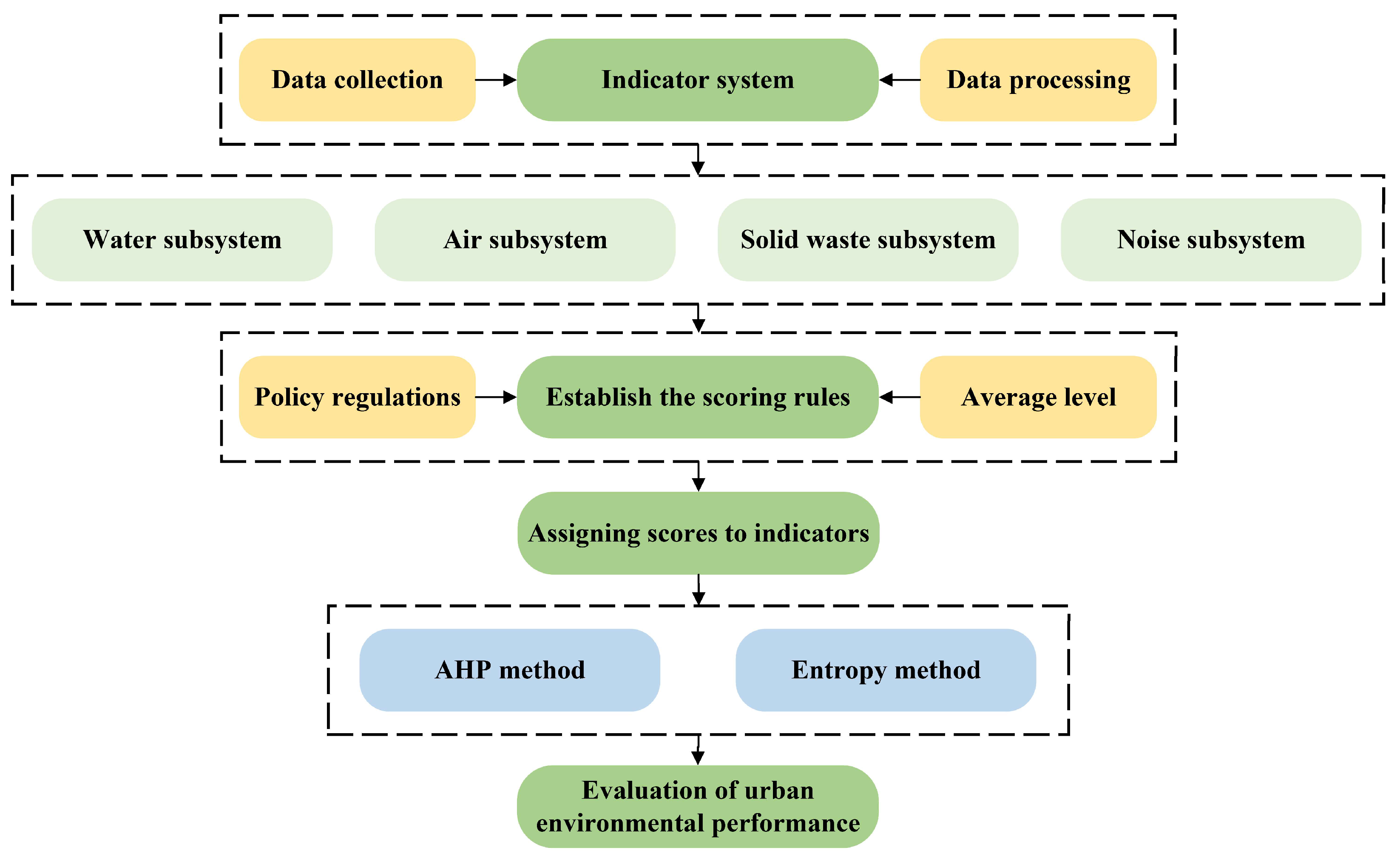
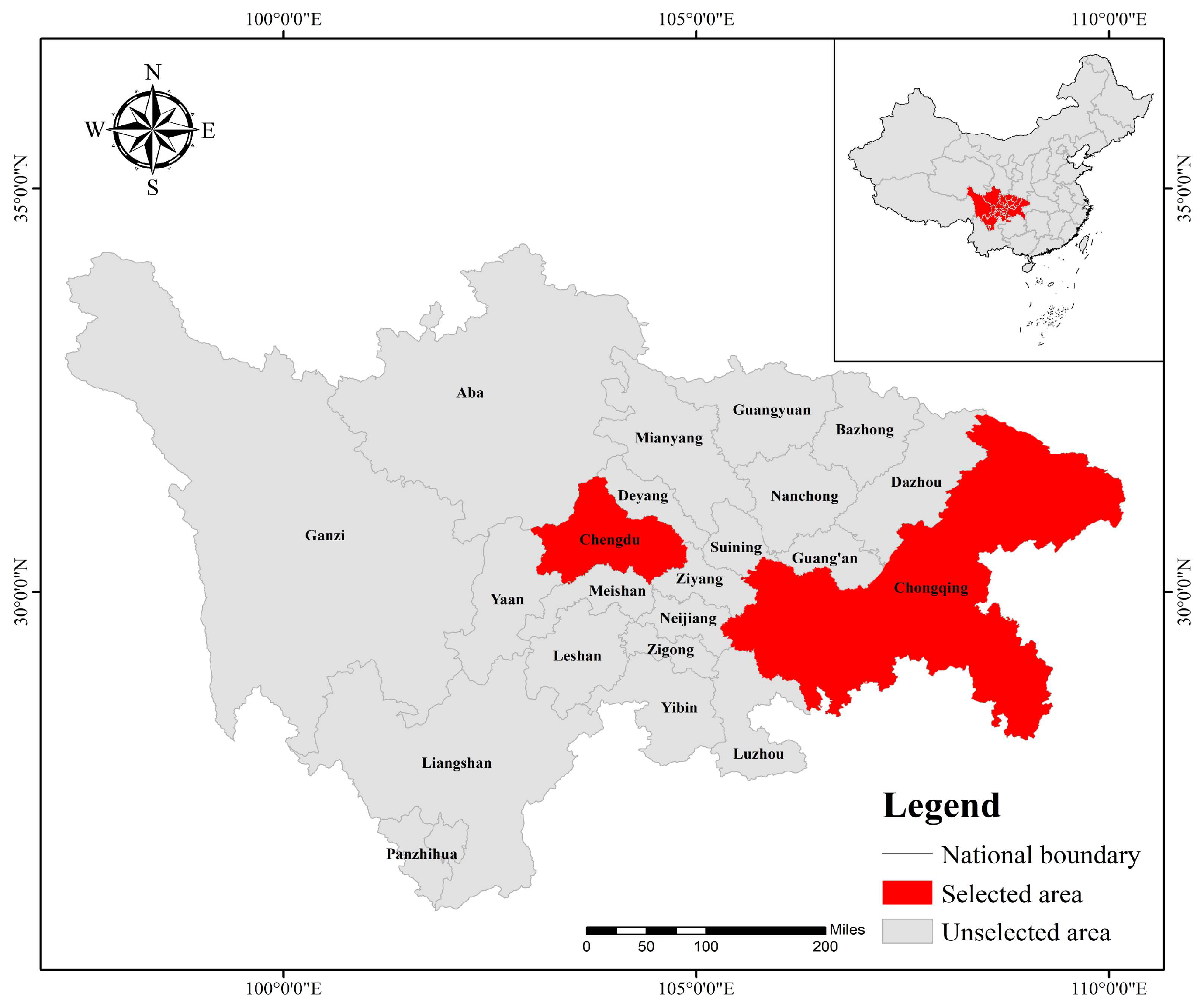
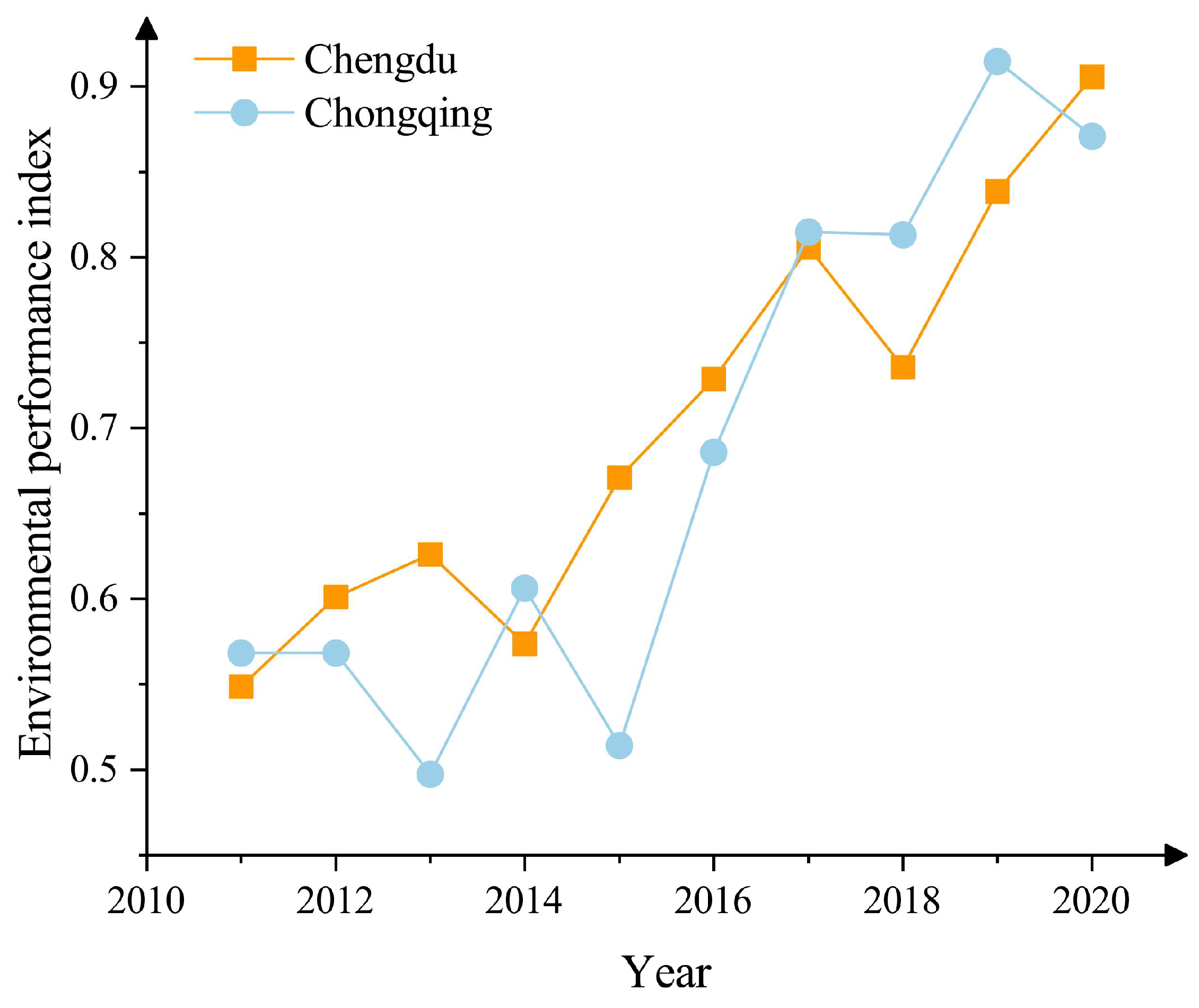
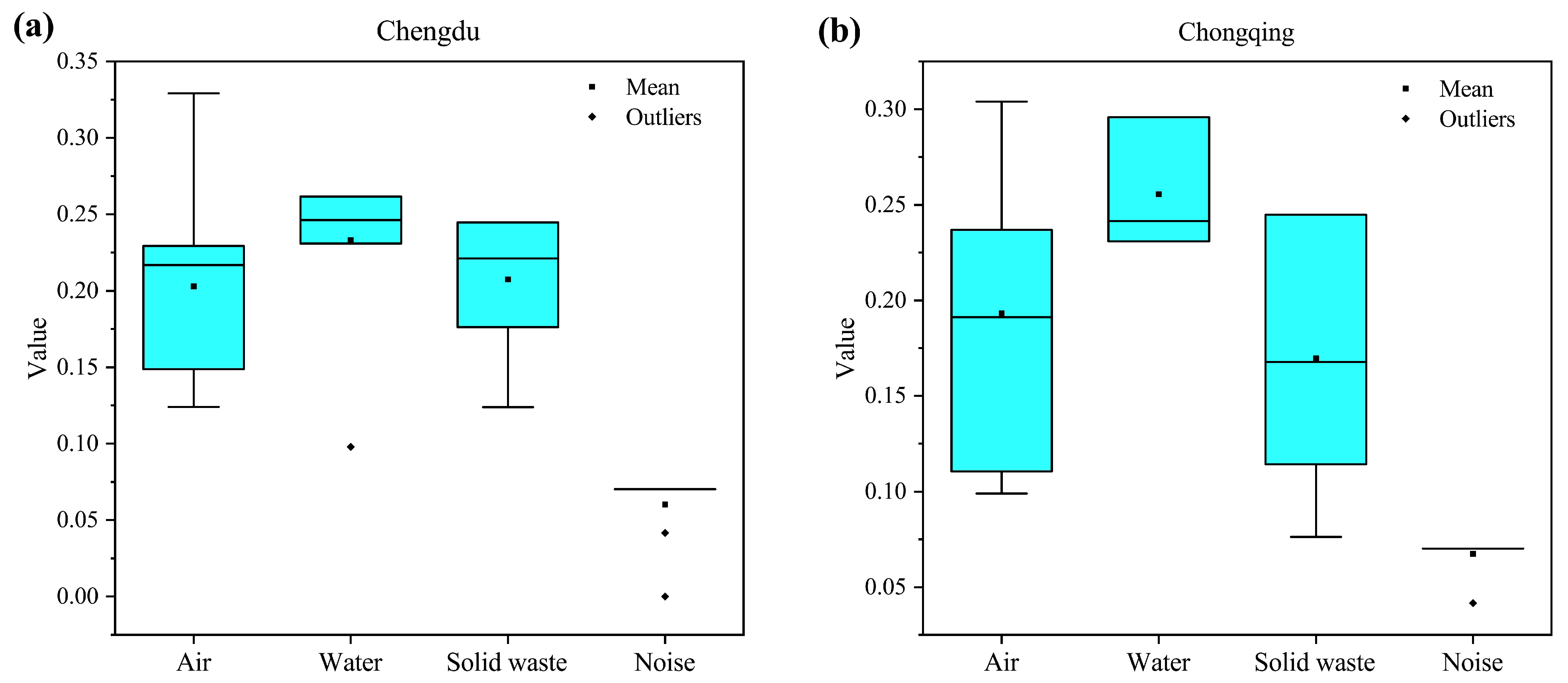

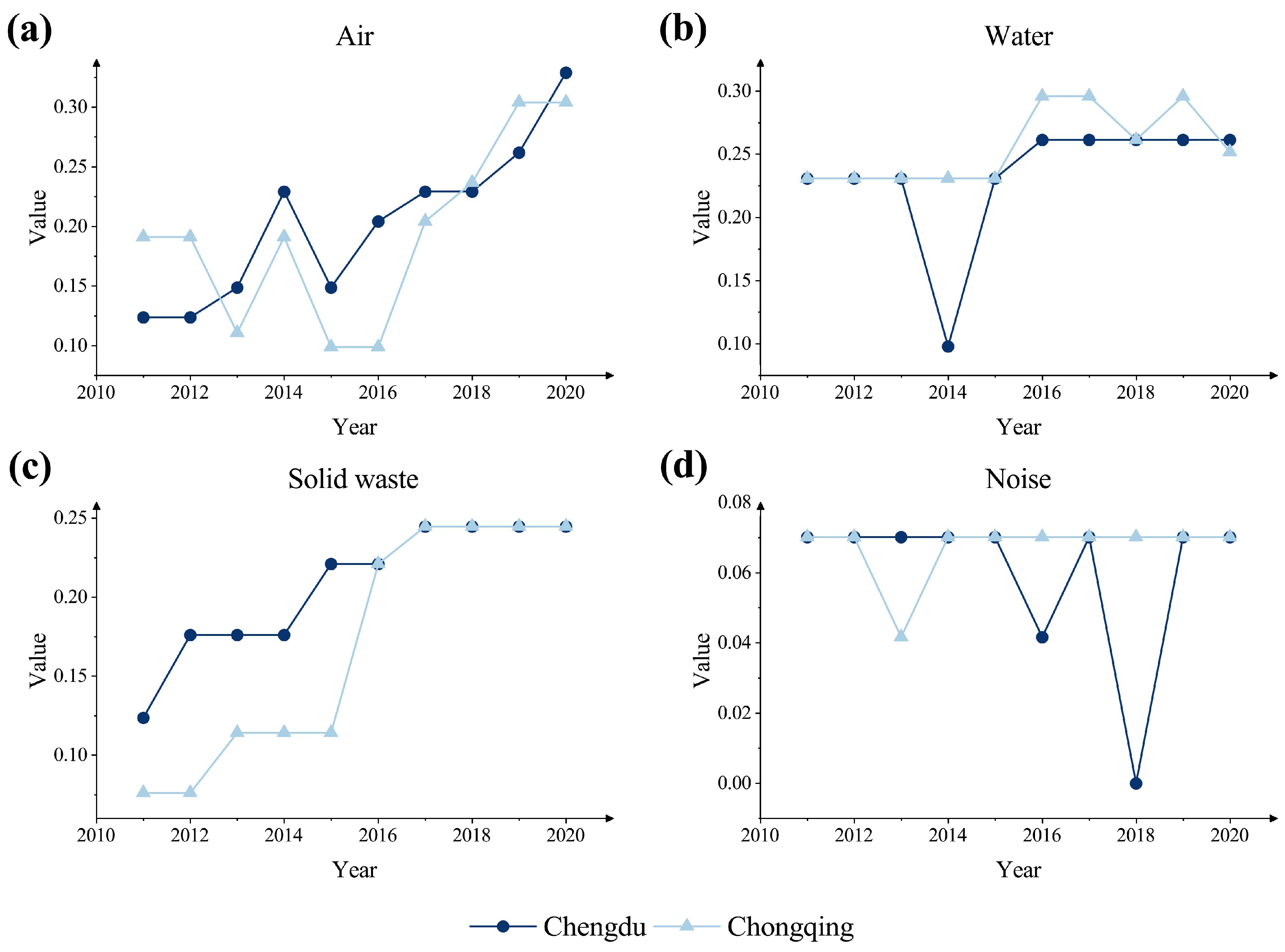
| Target | Primary Indicators | Secondary Indicators | Unit | Type |
|---|---|---|---|---|
| Environment Performances | Air (A) | PM10 Annual average concentration (A1) | μg/m3 | - |
| Annual average concentration (A2) | μg/m3 | - | ||
| Annual average concentration (A3) | μg/m3 | - | ||
| Average annual temperature (A4) | °C | - | ||
| Number of days with the air quality of Grade 2 or above (A5) | % | + | ||
| Annual share of good air quality days (A6) | Number of days | + | ||
| The treatment capacity of exhaust gas treatment equipment (A7) | Million m3/h | + | ||
| Water (B) | The urban water reuse rate (B1) | % | + | |
| Water conservation rate for urban water supply (B2) | % | + | ||
| The urban industrial water reuse rate (B3) | % | + | ||
| Water conservation rate in urban industry (B4) | % | + | ||
| Combined water consumption per capita (B5) | Liters per person. Day | - | ||
| Water consumption per GDP (B6) | Tons/million RMB | - | ||
| Unit urban wastewater discharge intensity (B7) | Tons/million RMB | - | ||
| Unit urban industrial effluent discharge intensity (B8) | Tons/million RMB | - | ||
| Solid waste (C) | Industrial solid waste generation (C1) | Million tons | - | |
| Comprehensive utilization of industrial solid waste (C2) | Million tons | + | ||
| The integrated utilization rate of industrial solid waste (C3) | % | + | ||
| Total domestic waste removal (C4) | Million tons | + | ||
| Harmless disposal rate of domestic waste (C5) | % | + | ||
| Household waste removal per capita (C6) | Kg/person. Day | + | ||
| Household waste disposal capacity (C7) | Tons/day | + | ||
| Noise (D) | Urban road traffic noise (D1) | dB(A) | - | |
| Urban ambient noise (D2) | dB(A) | - |
| Judgment Matrix | Air | Water | Solid Waste | Noise |
|---|---|---|---|---|
| Air | 1 | 1.072 | 2.048 | 1.966 |
| Water | 0.933 | 1 | 2.107 | 2.024 |
| Solid waste | 0.488 | 0.475 | 1 | 1.123 |
| Noise | 0.509 | 0.494 | 0.891 | 1 |
| n | 1 | 2 | 3 | 4 | 5 | … | 9 | 10 |
|---|---|---|---|---|---|---|---|---|
| RI | 0.00 | 0.00 | 0.58 | 0.90 | 1.12 | … | 1.45 | 1.49 |
| ζ | η | |
|---|---|---|
| Primary indicators | 0.233 | 0.767 |
| Secondary indicators | 0.193 | 0.807 |
| Primary Indicators | Secondary Indicators | Subjective Weights | Objective Weights | Portfolio Weights |
|---|---|---|---|---|
| Air (A) | PM10 Annual average concentration (A1) | 4.84% | 2.84% | 3.22% |
| Annual average concentration (A2) | 4.84% | 7.05% | 6.63% | |
| Annual average concentration (A3) | 4.84% | 4.15% | 4.29% | |
| Average annual temperature (A4) | 4.84% | 1.92% | 2.48% | |
| Number of days with air quality of Grade 2 or above (A5) | 4.84% | 2.25% | 2.75% | |
| Annual share of good air quality days (A6) | 4.84% | 2.25% | 2.75% | |
| The treatment capacity of exhaust gas treatment equipment (A7) | 4.84% | 11.71% | 10.39% | |
| Water (B) | The urban water reuse rate (B1) | 4.15% | 6.95% | 6.41% |
| Water conservation rate for urban water supply (B2) | 4.15% | 7.32% | 6.71% | |
| The urban industrial water reuse rate (B3) | 4.15% | 4.38% | 4.33% | |
| Water conservation rate in urban industry (B4) | 4.15% | 2.37% | 2.71% | |
| Combined water consumption per capita (B5) | 4.15% | 3.46% | 3.59% | |
| Water consumption per GDP (B6) | 4.15% | 2.27% | 2.63% | |
| Unit urban wastewater discharge intensity (B7) | 4.15% | 5.76% | 5.45% | |
| Unit urban industrial effluent discharge intensity (B8) | 4.15% | 2.77% | 3.04% | |
| Solid waste (C) | Industrial solid waste generation (C1) | 2.40% | 4.92% | 4.43% |
| Comprehensive utilization of industrial solid waste (C2) | 2.40% | 4.56% | 4.14% | |
| The integrated utilization rate of industrial solid waste (C3) | 2.40% | 2.34% | 2.36% | |
| Total domestic waste removal (C4) | 2.40% | 5.21% | 4.67% | |
| Harmless disposal rate of domestic waste (C5) | 2.40% | 1.87% | 1.97% | |
| Household waste removal per capita (C6) | 2.40% | 3.05% | 2.92% | |
| Household waste disposal capacity (C7) | 2.40% | 5.83% | 5.17% | |
| Noise (D) | Urban road traffic noise (D1) | 8.05% | 1.59% | 2.84% |
| Urban Ambient Noise (D2) | 8.05% | 3.18% | 4.12% |
| Secondary Indicator Parameters | Unit | Evaluation Criteria and Judgement Rules |
|---|---|---|
| PM10 Annual average concentration | Annual average concentration 70 [41] | |
| Annual average concentration | Annual average concentration 40 [41] | |
| Annual average concentration | Annual average concentration 60 [41] | |
| Average annual temperature | ℃ | Average 2011–2020 |
| Number of days with air quality of Grade 2 or above | % | Greater than 213 days [42] |
| Annual share of good air quality days | Number of days | Greater than 58.6% [42] |
| The treatment capacity of exhaust gas treatment equipment | Million /h | Average 2011–2020 |
| The urban water reuse rate | % | Combined water savings of >25% with urban water supply |
| Water conservation rate for urban water supply | % | Combined water savings of >25% with urban water supply |
| The urban industrial water reuse rate | % | Combined with urban industrial water savings of >50% |
| Water conservation rate in urban industry | % | Combined with urban industrial reuse rate greater than 50% |
| Combined water consumption per capita | Liters per person. Day | Less than 134.8 Liters per person. Day [43] |
| Water consumption per GDP | Tons/million RMB | Less than 57.6 Tons/million RMB [43] |
| Unit urban wastewater discharge intensity | Tons/million RMB | Average 2011–2020 |
| Unit urban industrial effluent discharge intensity | Tons/million RMB | Average 2011–2020 |
| Industrial solid waste generation | Million tons | Average 2011–2020 |
| Comprehensive utilization of industrial solid waste | Million tons | Average 2011–2020 |
| The integrated utilization rate of industrial solid waste | % | Greater than 80% [44] |
| Total domestic waste removal | Million tons | Average 2011–2020 |
| Harmless disposal rate of domestic waste | % | 100% |
| Household waste removal per capita | Kg/person. Day | Less than 1.12 kg/person. Day |
| Household waste disposal capacity | Tons/day | Greater than 0.55 million tons per day [45] |
| Urban road traffic noise | dB(A) | Less than 70 dB(A) [46] |
| Urban Ambient Noise | dB(A) | Less than 55 dB(A) [46] |
Disclaimer/Publisher’s Note: The statements, opinions and data contained in all publications are solely those of the individual author(s) and contributor(s) and not of MDPI and/or the editor(s). MDPI and/or the editor(s) disclaim responsibility for any injury to people or property resulting from any ideas, methods, instructions or products referred to in the content. |
© 2023 by the authors. Licensee MDPI, Basel, Switzerland. This article is an open access article distributed under the terms and conditions of the Creative Commons Attribution (CC BY) license (https://creativecommons.org/licenses/by/4.0/).
Share and Cite
Chen, L.; Huang, H.; Yao, D.; Yang, H.; Xu, S.; Liu, S. Construction of Urban Environmental Performance Evaluation System Based on Multivariate System Theory and Comparative Analysis: A Case Study of Chengdu-Chongqing Twin Cities, China. Int. J. Environ. Res. Public Health 2023, 20, 4515. https://doi.org/10.3390/ijerph20054515
Chen L, Huang H, Yao D, Yang H, Xu S, Liu S. Construction of Urban Environmental Performance Evaluation System Based on Multivariate System Theory and Comparative Analysis: A Case Study of Chengdu-Chongqing Twin Cities, China. International Journal of Environmental Research and Public Health. 2023; 20(5):4515. https://doi.org/10.3390/ijerph20054515
Chicago/Turabian StyleChen, Liang, Huan Huang, Dong Yao, Haonan Yang, Shuangshuang Xu, and Shiyu Liu. 2023. "Construction of Urban Environmental Performance Evaluation System Based on Multivariate System Theory and Comparative Analysis: A Case Study of Chengdu-Chongqing Twin Cities, China" International Journal of Environmental Research and Public Health 20, no. 5: 4515. https://doi.org/10.3390/ijerph20054515
APA StyleChen, L., Huang, H., Yao, D., Yang, H., Xu, S., & Liu, S. (2023). Construction of Urban Environmental Performance Evaluation System Based on Multivariate System Theory and Comparative Analysis: A Case Study of Chengdu-Chongqing Twin Cities, China. International Journal of Environmental Research and Public Health, 20(5), 4515. https://doi.org/10.3390/ijerph20054515





